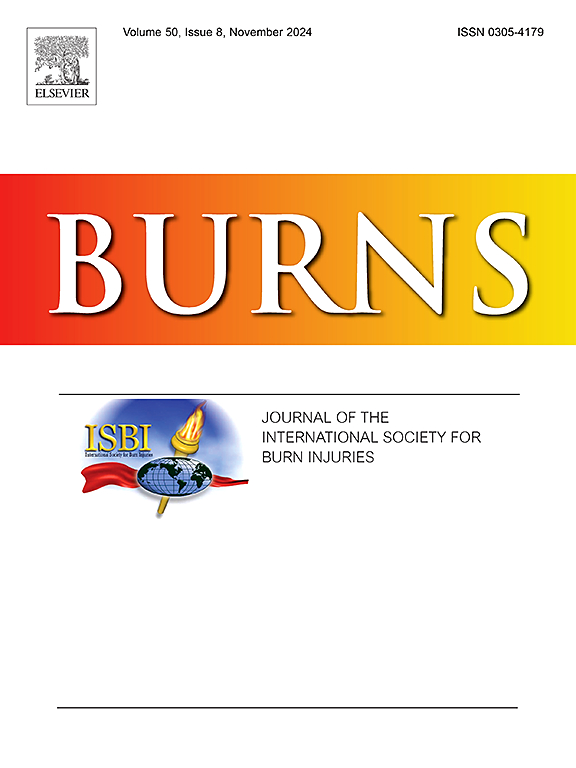Early ambulation following lower limb burn and surgery is associated with improved long-term functional outcome and reduced hospital length of stay: A longitudinal cohort study
IF 3.2
3区 医学
Q2 CRITICAL CARE MEDICINE
引用次数: 0
Abstract
Introduction
Ambulating early after lower limb burn surgery has been associated with a multitude of in-hospital and short-term benefits. However, long-term functional recovery following lower limb burns is poorly understood, especially if grafting surgery is required.
Objectives
This study aimed to explore the association between early ambulation following lower limb burn injury and surgery, long-term lower limb functional recovery and secondly, hospital length of stay (LOS).
Methods
This retrospective longitudinal cohort study reported data from 1718 adult patients treated by a tertiary hospital burn center in Western Australia between February 2011 and December 2019 following a lower limb burn injury.
Results
Comparable lower limb function outcomes were found at six weeks after injury regardless of burn severity or timing of ambulation. Early ambulation pathways were associated with the likelihood of achieving a better long-term functional recovery over the first year after burn. A positive association was also confirmed between early ambulation and hospital LOS. After adjustment, patients who ambulated early after burn and surgery had a LOS of 1.76 days less than patients who ambulated early after burn but late after surgery (IRR 1.22, 95 % CI:1.13–1.3, p < 0.001).
Conclusion
Early ambulation before the third day after lower limb burn injury and surgery was associated with improved long-term functional outcome trajectory to one year and reduced hospital LOS by of 1.76 days when patients ambulated early after surgery. Future investigations with larger, targeted samples of complex patients are warranted to explore the influence of early ambulation on the outcomes of multi-morbidity subgroups.
下肢烧伤和手术后尽早行走与改善长期功能预后和缩短住院时间有关:纵向队列研究
下肢烧伤术后早期走动与许多住院和短期益处相关。然而,下肢烧伤后的长期功能恢复尚不清楚,特别是如果需要移植手术。目的探讨下肢烧伤术后早期下床活动与长期下肢功能恢复及住院时间(LOS)的关系。方法本回顾性纵向队列研究报告了2011年2月至2019年12月期间在西澳大利亚一家三级医院烧伤中心接受治疗的1718名成人下肢烧伤患者的数据。结果无论烧伤严重程度或活动时间如何,损伤后6周的下肢功能结果均具有可比性。早期的活动路径与烧伤后第一年实现更好的长期功能恢复的可能性有关。早期活动与医院LOS之间也证实了正相关。调整后,烧伤术后早期下床的患者比烧伤术后早期下床的患者LOS少1.76天(IRR 1.22, 95 % CI: 1.13-1.3, p <; 0.001)。结论下肢烧伤及手术后第3天前早期下床活动可改善患者1年的长期功能预后轨迹,并可使患者术后早期下床活动减少1.76天的住院时间。未来有必要对复杂患者进行更大、更有针对性的调查,以探索早期活动对多发病亚组结果的影响。
本文章由计算机程序翻译,如有差异,请以英文原文为准。
求助全文
约1分钟内获得全文
求助全文
来源期刊

Burns
医学-皮肤病学
CiteScore
4.50
自引率
18.50%
发文量
304
审稿时长
72 days
期刊介绍:
Burns aims to foster the exchange of information among all engaged in preventing and treating the effects of burns. The journal focuses on clinical, scientific and social aspects of these injuries and covers the prevention of the injury, the epidemiology of such injuries and all aspects of treatment including development of new techniques and technologies and verification of existing ones. Regular features include clinical and scientific papers, state of the art reviews and descriptions of burn-care in practice.
Topics covered by Burns include: the effects of smoke on man and animals, their tissues and cells; the responses to and treatment of patients and animals with chemical injuries to the skin; the biological and clinical effects of cold injuries; surgical techniques which are, or may be relevant to the treatment of burned patients during the acute or reconstructive phase following injury; well controlled laboratory studies of the effectiveness of anti-microbial agents on infection and new materials on scarring and healing; inflammatory responses to injury, effectiveness of related agents and other compounds used to modify the physiological and cellular responses to the injury; experimental studies of burns and the outcome of burn wound healing; regenerative medicine concerning the skin.
 求助内容:
求助内容: 应助结果提醒方式:
应助结果提醒方式:


